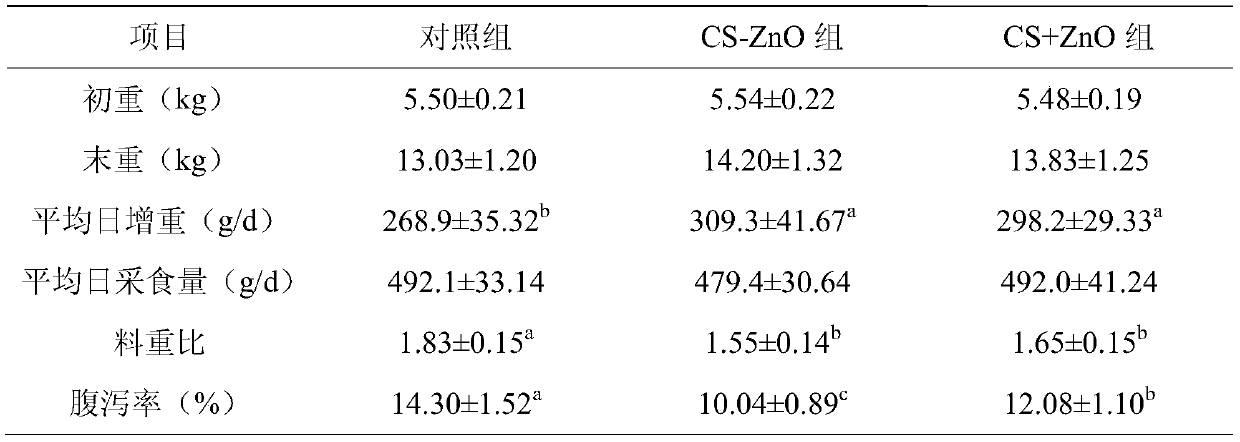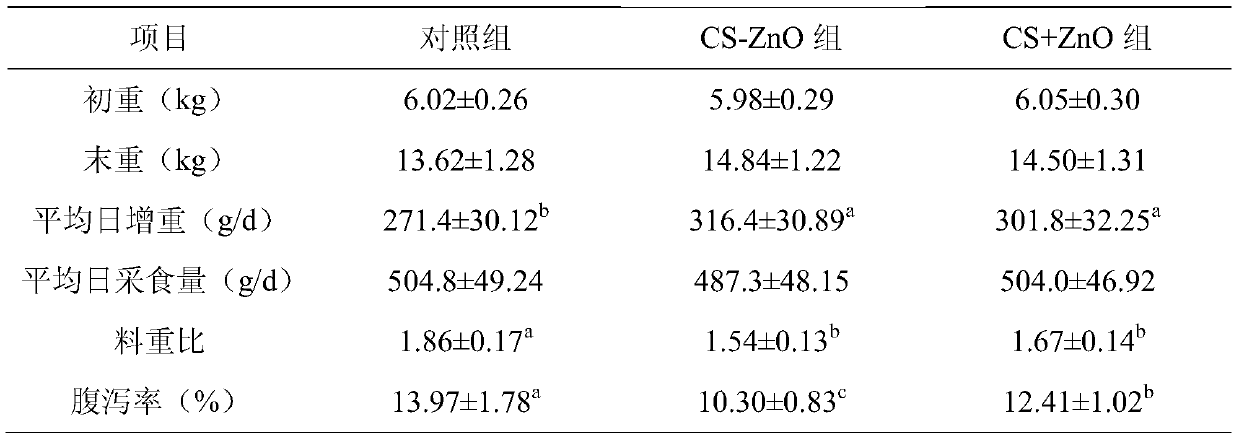Application of cs-zno as an immune enhancer for piglet intestinal mucosa
A technology of immune enhancer and intestinal mucosa, which is applied in the application field of compound in livestock and poultry feed, can solve the problems of low absorption rate and utilization rate of inorganic zinc, resource waste environment, excessive zinc content, etc., and achieve the goal of improving daily growth weight loss, relieve inflammatory response, and reduce the content of pro-inflammatory factors
- Summary
- Abstract
- Description
- Claims
- Application Information
AI Technical Summary
Problems solved by technology
Method used
Image
Examples
Embodiment 1
[0015] In this experiment, 90 piglets with a body weight of 5.5 kg and weaned at 21 days were randomly divided into 3 groups (3 replicates in each group, 10 pigs in each replicate), and were randomly divided into 3 groups according to the requirements of the feeding experiment. . Three different diets were tested, the control group was corn-soybean meal based diet, and the experimental group was added 100mg / kg chitosan-zinc oxide complex (CS-ZnO) and 100mg / kg shell Polysaccharide and zinc oxide mixture (CS+ZnO, the mass ratio of CS to ZnO is 1:2), the above additions are calculated as zinc, and the basic diet is prepared according to the nutritional requirements of piglets in the United States NRC (1998). The experimental pigs were group-fed in pens and had free access to food and water. Before the test, the pig house was sterilized with 1% Disinfectant, the pre-test period was 7 days, and the main test period was 28 days. During the test, the feed consumption was recorded e...
Embodiment 2
[0022] In this experiment, 90 piglets with a body weight of 6.0 kg and weaned at 24 days were randomly divided into 3 groups (3 replicates in each group, 10 pigs in each replicate), and were randomly divided into 3 groups according to the requirements of the feeding experiment. . Three different rations were tested, the control group was corn-soybean meal basal ration, and the experimental group added 250mg / kg chitosan-zinc oxide complex (CS-ZnO) and 250mg / kg shell Polysaccharide and zinc oxide mixture (CS+ZnO, the mass ratio of CS to ZnO is 1:2), the above additions are calculated as zinc, and the basic diet is prepared according to the nutritional requirements of piglets in the United States NRC (1998). The experimental pigs were group-fed in pens and had free access to food and water. Before the test, the pig house was sterilized with 1% Disinfectant, the pre-test period was 7 days, and the main test period was 28 days. During the test, the feed consumption was recorded e...
Embodiment 3
[0030]In this experiment, 90 piglets with a body weight of 6.5 kg and weaned at 28 days were selected and randomly divided into 3 groups (3 replicates in each group, 10 pigs in each replicate). They were randomly divided into 3 groups according to the requirements of the feeding experiment. . Three different rations were tested, the control group was corn-soybean meal basal ration, and the experimental group added 600mg / kg chitosan-zinc oxide complex (CS-ZnO) and 600mg / kg shell Polysaccharide and zinc oxide mixture (CS+ZnO, the mass ratio of CS to ZnO is 1:2), the above additions are calculated as zinc, and the basic diet is prepared according to the nutritional requirements of piglets in the United States NRC (1998). The experimental pigs were group-fed in pens and had free access to food and water. Before the test, the pig house was sterilized with 1% Disinfectant, the pre-test period was 7 days, and the main test period was 28 days. During the test, the feed consumption w...
PUM
 Login to View More
Login to View More Abstract
Description
Claims
Application Information
 Login to View More
Login to View More - R&D
- Intellectual Property
- Life Sciences
- Materials
- Tech Scout
- Unparalleled Data Quality
- Higher Quality Content
- 60% Fewer Hallucinations
Browse by: Latest US Patents, China's latest patents, Technical Efficacy Thesaurus, Application Domain, Technology Topic, Popular Technical Reports.
© 2025 PatSnap. All rights reserved.Legal|Privacy policy|Modern Slavery Act Transparency Statement|Sitemap|About US| Contact US: help@patsnap.com



